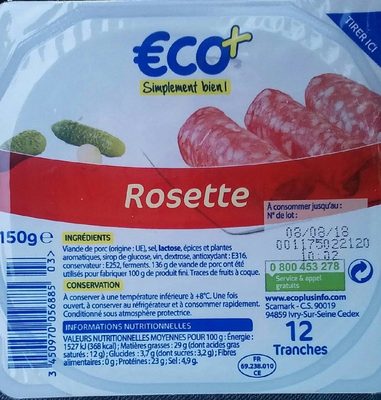Rosette - Eco+ - 150 g
This product page is not complete. You can help to complete it by editing it and adding more data from the photos we have, or by taking more photos using the app for Android or iPhone/iPad. Thank you!
×
Barcode: 3450970056885 (EAN / EAN-13)
Quantity: 150 g
Brands: Eco+
Categories: Meats and their products, Meats, Prepared meats, Cured sausages, Rosette dry sausage
Labels, certifications, awards:
Green Dot
Traceability code: EMB 69238J - Saint-Symphorien-sur-Coise (Rhône, France), FR 69.238.010 CE - Saint-Symphorien-sur-Coise (Rhône, France)
Stores: Leclerc
Countries where sold: France
Matching with your preferences
Environment
Carbon footprint
Packaging
Transportation
Report a problem
Data sources
Product added on by date-limite-app
Last edit of product page on by spotter.
Product page also edited by kiliweb, openfoodfacts-contributors, packbot, quechoisir, roboto-app, sebleouf, tacite, yuka.VkxrckhJZ2xpZmtVaWNFWnB6MkUwZTFmM1lhV2ZsbVNGOEJBSVE9PQ.










